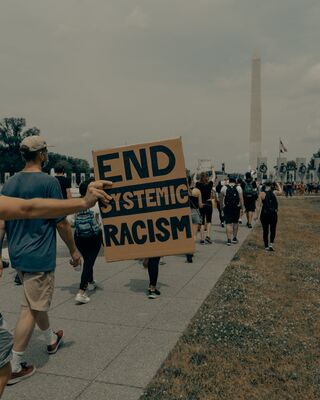Bias
How Systemic Racism Self-Perpetuates
Media highlights racial stereotypes.
Posted December 13, 2020

“... People internalize what they see … [and] the American media portrays idealized representations of White Americans and marginalizes and minimizes people who are not White.” —The Bronfenbrenner Center for Translational Research1
I was really excited when the church I had been attending for a while in Rosemead, CA, announced they were holding a class on racial awareness. Immediately following the murder of George Floyd, the church had already established a committee to consider a response to the racial injustice in our country. This became even more crucial when the COVID pandemic hit and some in that church were losing jobs. The class, I presume, also came about to raise racial awareness for a church whose membership is primarily Asian-American. Both, I believe, were the church’s way to show solidarity with the Black community and other marginalized groups, of which Asian-Americans are one.
In speaking to some of the congregation, I quickly realized that although many Asian-Americans have experienced racism on a personal level, very few actually understood that racism in the United States is systemic. I found this to be true of the majority of whites as well. (Please see my definition of systemic racism here.)
Systemic racism is historically embedded in our federal, state, and local policies and laws, all favoring white males. Now that the nation is becoming more diverse, with groups of different skin colors being appointed and/or elected into all levels of government, the laws and policies will gradually reflect the needs of all. However, I believe that the racial tension spiking is because of the struggle for power as this nation goes forward. For those in power, they are fighting to maintain what they have. For those with no power, they are fighting for equality.
How the Media Perpetuates Racism
Midway through the course, one of the co-facilitators showed us a video called “Applied,” by journalist Alexandra Bell, recipient of a 2018 ICP Infinity award. The video highlights Bell’s work, in which she creates alternate versions of real newspaper layouts to show how headlines, images, and the size and placement of photos perpetuate systemic racism in the media.
As I mentioned before, I thought I knew a lot about this subject. However, I was shocked when I saw how racism was and still is represented in journalism. And, in certain instances, I’m not sure that the journalists, editors, and photographers whose work was featured in the video even realized it. Here is the link to the video if you’d like to see it for yourself.
The video first shows a layout in The New York Times featuring stories of Darren Wilson and Michael Brown, Jr. side by side. Wilson, a 28-year-old police officer, fatally shot 18-year-old Brown in 2014.
Bell points out how the headline, as well as the size and placement of both photos, gives the impression that the young teenage Black boy is on equal footing with the white policeman. The headline implies that they are each at a “crossroads,” starting out in the next stage of their lives. To me, it gives the appearance that they not only have similar experiences to get to where they’re at, but also that the future climb to success is similar, if not the same. They’re not!
Bell also critiques a front-page layout that included a story about white nationalist protests turning violent in Charlottesville, VA. She notes that despite the severity of the situation, the story was minimized to just a third of the page. Next, the video includes news footage depicting white men, holding candles, marching in an orderly fashion, with police standing quietly by. In these examples, again, it implies that violence only happens when Black people are involved; whereas, white people are shown as law-abiding.
In another news report, the original version is depicted as a “Tulsa Man, Accused of Harassing Lebanese Family, Is Charged With Murder." While the race of both the alleged murderer and the victim are shown in the photos, nothing was stated that it was a white man who racially harassed this family for years, then killed a Middle Eastern man. The stereotype that those in the marginalized group were “harassed” rather than “a crime of hate” minimizes the severity of the act and puts the white group in a more favorable light. What’s depicted, while factually accurate, gives the message that this is a regular homicide, not a racially targeted one. It exemplifies the saying, “A picture is worth 1,000 words.”
I knew on an intellectual level that racism is endemic in our society and that the media is part and parcel of perpetuating the inequalities based on skin color. What I didn’t know is how that was done. The shock for me was the way it was depicted in the size and angles of the pictures and in direct language or the lack thereof. When racism is not spoken out loud, the group in power can justify saying to the marginalized group:
- You people are over-sensitive!
- You people see everything as racist.
- Can’t you people even take a joke?
Having those very words thrown at me, made it difficult, if not impossible, to come back with any objective response to such subjective remarks. Who wouldn’t be over sensitive? How could I not wonder if what’s being thrown at me isn’t racism, especially after being racially targeted throughout childhood? I have to say that, short of violence, I prefer overt forms of racism. That way, at least I know exactly where I stand. There is something tangible I can confront.
Covertly, the group in power can make excuses, blaming the victim, as it were. They get to maintain their belief that they are superior and, absolving themselves of any responsibility for perpetuating unequal social justice, can continue to believe that this is the right order of the world. Therefore, covert racism is hidden so that we only get to see the overt in terms of White nationalists like the KKK. We can continue to pretend that it’s only a small group of racists that are making a lot of noise. Until we acknowledge that both overt and covert forms of racism are intrinsically intertwined with each other to perpetuate the power of the white group over the groups of people of color, we will not achieve social justice for all.
The question, then, is: Does the majority of the United States want social justice for all, because it will mean that those holding the power will need to actually compete with are considered “lesser” groups on a level playing field!
References
1. The Bronfenbrenner Center for Translational Research , Evidenced-Based Living, What Research Tells Us About The Psychology of Racism, A new review takes a broad look at hows and whys of racism in American society, psychologytoday.com, June 19, 2020




